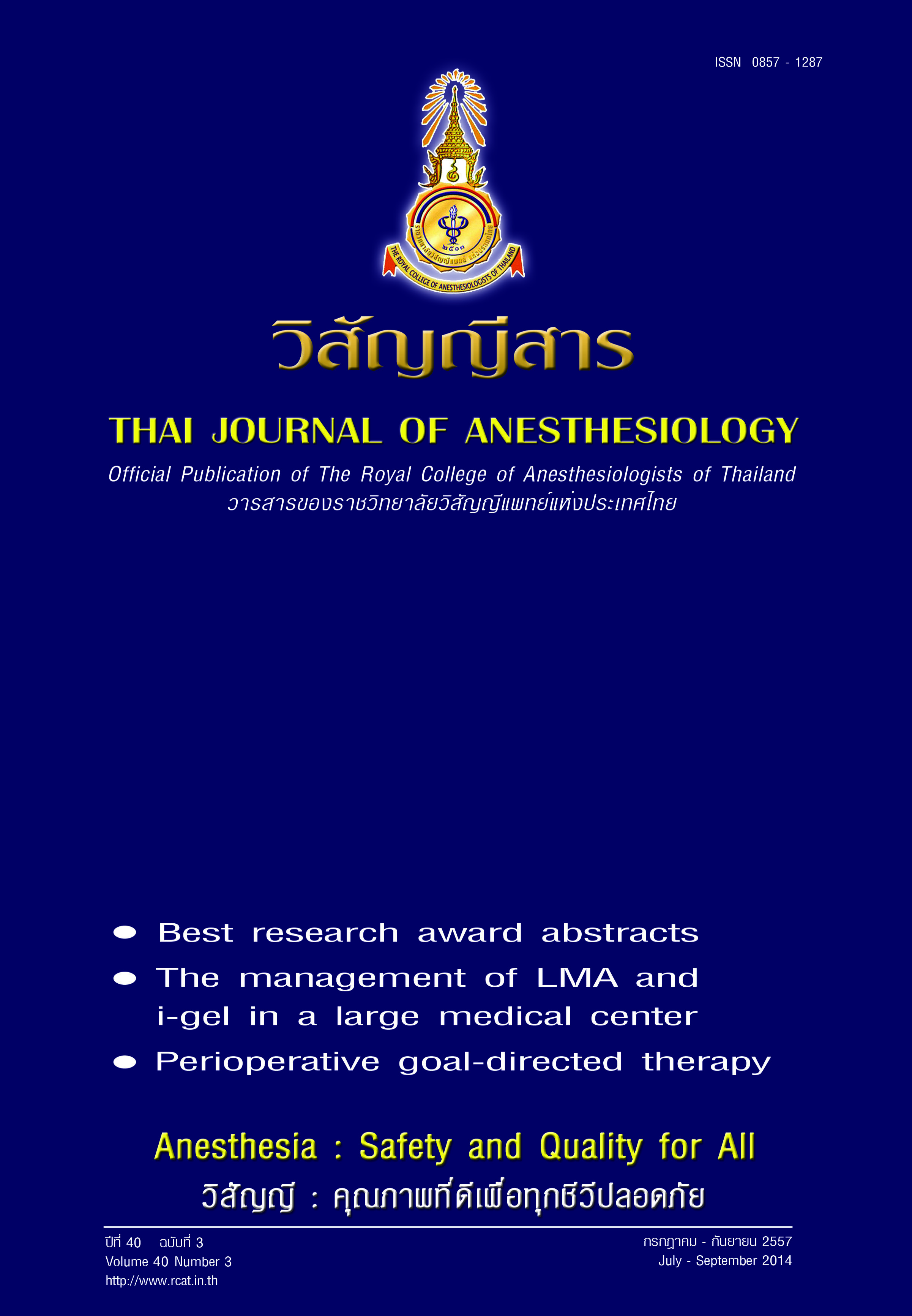Comparison of number of patients with Bispectral index values < 60 during neonatal delivery between 1% and 1.2% Sevoflurane in 50% N2O in patients undergoing cesarean section under general anesthesia
Main Article Content
Abstract
Background: Patients undergoing cesarean section under general anesthesia are at high risk for intraoperative recall. We have shown previously that using 1% sevoflurane (vaporizer setting) in 50% N2O resulted in a high mean BIS values of 64.50 ± 12.60. Only 5 of 30 (16.7%) of women had BIS values < 60 during delivery, indicating inadequate depth of anesthesia. Using a higher concentration of sevoflurane may result in better results while maintaining hemodynamic profiles and Apgar scores.
Objectives: To compare the number of patients with BIS values < 60 during neonatal delivery between 1% vs. 1.2% sevoflurane ETC in 50% N2O with gas flows of 6 l/min.
Methods: A prospective randomized controlled trial of 1% vs. 1.2% sevoflurane ETC groups (group 1 vs. group 2) was conducted in 28 pregnant women ASA physical status 2 who underwent elective cesarean section under general anesthesia. All patients were induced with thiopental 5 mg/kg and intubated with succinylcholine 1.5 mg/kg. After intubaton, group 1 received 1% sevoflurane ETC while group 2 received 1.2% sevoflurane ETC in O2: N2O 3:3 l/min. Both groups received cis - atracurium 0.15 mg/kg. After delivery, sevoflurane was reduced to 0.6% and O2: N2O were reduced 1: 2 l/min, midazolam 0.03 mg/kg and morphine 0.15 mg/kg were given in both groups. When the operation finished, neostigmine and atropine were given and the patients were extubated awake.
Results: The number of patients with BIS values < 60 during delivery was significantly higher in group 2: 12 of 14 (85.7%) vs.4 of 14 (28.6%) in group 1 (P = 0.002). The median (IQR) BIS values were 42 (34 - 55) vs. 62 (44 - 65), respectively (P = 0.001). Demographic variables, hemodynamic profiles, estimated blood loss, methylergometrine, ephedrine and Apgar scores were not significantly different between groups. None of the patients in either reported any recall.
Conclusions: The number of patients with BIS values < 60 during delivery in cesarean section under general anesthesia using 1.2% sevoflurane ETC in 50% N2O with gas flows of 6 l/min was higher than using 1% sevoflurane ETC while providing comparable maternal hemodynamic profiles and neonatal Apgar scores.
การเปรียบเทียบจำนวนผู้ป่วยที่มีค่า Bispectral index น้อยกว่า 60 ขณะทารกคลอด ระหว่างการใช้ 1% และ 1.2% Sevoflurane ใน 50% N2O ในการระงับความรู้สึกแบบทั้งตัวในผู้ป่วยที่มารับการผ่าตัดคลอดทางหน้าท้อง
บทนำ: ผู้ป่วยที่มารับการผ่าตัดคลอดทางหน้าท้องด้วยการระงับความรู้สึกแบบทั้งตัว เป็นกลุ่มเสี่ยงสูงต่อการรู้ตัวขณะผ่าตัด การศึกษาที่ผ่านมาพบว่า การใช้ 1% sevoflurane (vaporizer setting) ใน 50% N2O ได้ค่าเฉลี่ย BIS ขณะทารกคลอด เป็น 64.50 ± 12.60 และผู้ป่วย 5 จาก 30 คน (16.7%) มีค่า BIS < 60 แสดงว่าผู้ป่วยส่วนใหญ่อาจได้รับการระงับความรู้สึกไม่ลึกพอ การเพิ่มความเข้มข้นของ sevoflurane น่าจะช่วยเพิ่มจำนวนผู้ป่วยที่มีค่า BIS < 60 โดยไม่เพิ่มผลเสียต่อมารดาและทารก
วัตถุประสงค์: เพื่อเปรียบเทียบจำนวนผู้ป่วยที่มีค่า BIS < 60 ขณะทารกคลอด ระหว่างการใช้ 1% และ 1.2% sevoflurane ETC ใน O2 : N2O 3:3 ลิตร/นาที
วิธีการศึกษา: เป็นการศึกษาแบบ prospective randomized controlled trialในหญิงตั้งครรภ์ที่มารับการผ่าตัดคลอดด้วยวิธีระงับความรู้สึกแบบทั้งตัว ASA physical status 2 จำนวน 28 คน แบ่งเป็น 2 กลุ่ม คือ กลุ่ม 1% และกลุ่ม 1.2% sevoflurane ETC (กลุ่ม 1 และ กลุ่ม 2) นำสลบทุกคนด้วย thiopental 5 มก./กก. ใส่ท่อหายใจด้วย succinylcholine 1.5 มก./กก. จากนั้นกลุ่ม 1 ได้รับ 1% sevoflurane ETC กลุ่ม 2 ได้รับ 1.2% sevoflurane ETC ใน O2 : N2O 3:3 ลิตร/นาที ทุกคนได้ cis-atracurium 0.15 มก./กก. หลังทารกคลอด ทั้ง 2 กลุ่มจะปรับลด sevoflurane เป็น 0.6% และลด O2 : N2O เป็น 1:2 ลิตร/นาที ให้ midazolam 0.03 มก./กก. และ morphine 0.15 มก./กก. หลังผ่าตัดเสร็จ ให้ neostigmine และ atropine ถอดท่อหายใจเมื่อผู้ป่วยตื่นดี
ผลการศึกษา: จำนวนผู้ป่วยที่มีค่า BIS < 60 ขณะทารกคลอด ในกลุ่ม 2 คือ 12 จาก 14 คน (85.7%) ซึ่งแตกต่างอย่างมีนัยสำคัญทางสถิติกับกลุ่ม 1 ที่พบ 4 จาก 14 คน (28.6%) (P = 0.002) ไม่พบความแตกต่างของข้อมูลพื้นฐาน ความดันเลือด อัตราการเต้นของหัวใจ ปริมาณเลือดที่เสีย ไม่มีรายใดได้ methylergometrine เพิ่มเติม ไม่มีรายใดได้ ephedrine ไม่พบความแตกต่างระหว่างกลุ่มของ Apgar scores ไม่พบรายใดรู้ตัวขณะผ่าตัด
สรุป: จำนวนผู้ป่วยที่มีค่า BIS < 60 ขณะทารกคลอด โดยใช้ 1.2% sevoflurane ETC ใน O2 : N2O 3:3 ลิตร/นาที (50% N2O) มีมากกว่าการใช้ 1% sevoflurane ETC โดยผลต่อความดันเลือด อัตราการเต้นของหัวใจ การเสียเลือดของมารดา และผลต่อ Apgar scores ของทารกไม่ต่างกัน


